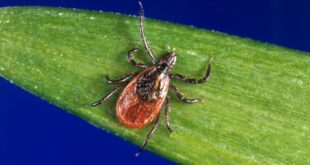Pest species taking wing early this year following hot, dry spring weather

Driven by drought, heat-loving grasshoppers are thriving in Alberta, threatening to devour crops in central and southern parts of the province.
Pest species of grasshoppers are taking wing early this year — and swarming in greater numbers.
Robert Badry, who operates his family's cereal farm near Heisler, 160 kilometres southeast of Edmonton, said half an acre of his wheat crop was devoured in a matter of days.
"The ground was literally moving with them," he said. "It was bare, you could see the soil. They just eat it to nothing."
Grasshoppers have been long been a menace to agricultural producers. Like locusts, the insects are incredibly destructive. Even a moderate infestation — 10 grasshoppers per square metre — can consume up to 60 per cent of available vegetation.
This year, the hot and dry weather that fuelled historic wildfires in Alberta has contributed to a scourge of grasshoppers now threatening to strip already stunted crops.
Experts warn the infestations increase the risk of future outbreaks and serve as a reminder of the need to better monitor the pests.
Recent rains may have slowed down the grasshoppers — but only temporarily, as populations have been booming for years.
On his farm, Badry is concerned about the prospect of persistent outbreaks.
He expects grasshoppers will move in again when arid weather returns. His crops are already suffering from lack of moisture, leaving them to susceptible to poor yields and pests.
"Once the drought hits and then you see the grasshoppers, you can't be surprised, they go hand in hand," he said. "They flourish in the drought and the dry.
"If it's not one thing it's another this year."
The Alberta government monitors grasshopper outbreaks and tracks populations through an annual count conducted each August.
Last year's survey warned of the ongoing risk of outbreaks in southern Alberta and along the border with Saskatchewan. Infestations were found in isolated pockets in the Peace River region. In the south and east, numbers have been expanding since 2021, the survey found.
A plague of pests
Meghan Vankosky, a research scientist with Agriculture and Agri-Food Canada and co-chair of the Prairie Pest Monitoring Network, said 2023 is the worst year for grasshoppers she has seen in more than two decades.
After the wildfires and record rains in Alberta this year, it's an anxious time for producers, Vankosky said.
"With the fire and the flood, we're talking about the Four Horsemen of the Apocalypse, right?" she quipped.
Vankosky urges farmers to keep close watch over their crops. As other food sources such as wild grasses, flowers and leafy plants dry out, grasshoppers will move onto crops for a meal.
"It's not just that we have a lot of grasshoppers this year, it's that the crops aren't necessarily growing very well and so that damage is just that much more noticeable," Vankosky said.
"They do tend to prefer cereals, oats, wheat, rye, barley … But in a drought year, they're going to eat really anything they can find."

Although the life cycle varies between species, grasshoppers invariably thrive in heat.
Females lay eggs in soil late in the summer. After a winter just below the surface, nymphs hatch from their seed pods in spring. They feed on vegetation as they grow into adulthood, moult and grow wings.
Warm weather increases survival rates and accelerates each phase. The insect's body temperature shoots up, allowing for faster growth and for females to produce more eggs, leading to increasingly bigger hatches each spring.
Vankosky said higher temperatures this year have allowed the insects to take wing early, flying to new food sources.
"When it's hot, they develop faster than normal, which is really what we've seen this year."
Alberta is no stranger to outbreaks. In 2021, grasshoppers swarmed in Lethbridge, destroying fields and backyard gardens.
Before its extinction in the late 19th century, a grasshopper known as the Rocky Mountain locust swarmed across the West. Blizzards of the bugs would obscure the sun.
Grasshopper expert Dan Johnson, a professor of environmental science at the University of Lethbridge, recalls outbreaks in the 1980s when cars and trucks were forced off the road by clouds of grasshoppers hanging thick over highways.
Johnson describes this year's infestations in Alberta as "patchy," with isolated hot spots where populations are dense.
"Where they are, they're very heavy," he said. "And it's a double whammy because they come when the drought is already causing trouble."
Friend or foe
Johnson said pest populations have been creeping up since 2018. Recent infestations should serve as a reminder that not all grasshoppers pose a threat to producers, he said, adding that the pests can be selectively managed with pesticides.
Some species are harmless to crops and play an important part in the grasslands ecosystem, serving as meals for birds and other prey.
"There are about 50 fairly common species and only about five of them are the bad guys," Johnson said.
Pest species include the clear-winged grasshopper, Packard's grasshopper, the migratory grasshopper and the two-striped grasshopper, which is considered the largest threat.
The Bruner's spur-throated grasshopper is a relatively new villain on the list of species prevalent in Alberta, Johnson said.
Populations of Bruner's grasshoppers have shot up in recent years with numbers reported from Edmonton to the Peace River region. Johnson expects their range and numbers will continue to grow.
Governments and producers need to be better prepared for possible invasions, Johnson said.
The current surge in numbers has been made possible by sequential years of drought: warm, dry springs and hot early summers. If the trend continues, serious infestations will continue to escalate, he said.
Grasshoppers and locusts are a global threat to food security and an international effort is required to knock back problem species, he said. Predicting population booms — and the extent of the damage that will be caused — can be incredibly difficult, but the risks must be managed.
"We can never really wipe them out," he said. "But if we can make sure they don't get completely out of hand, that's the way to do it."

*****
Credit belongs to : www.cbc.ca
 MaharlikaNews | Canada Leading Online Filipino Newspaper Portal The No. 1 most engaged information website for Filipino – Canadian in Canada. MaharlikaNews.com received almost a quarter a million visitors in 2020.
MaharlikaNews | Canada Leading Online Filipino Newspaper Portal The No. 1 most engaged information website for Filipino – Canadian in Canada. MaharlikaNews.com received almost a quarter a million visitors in 2020.







